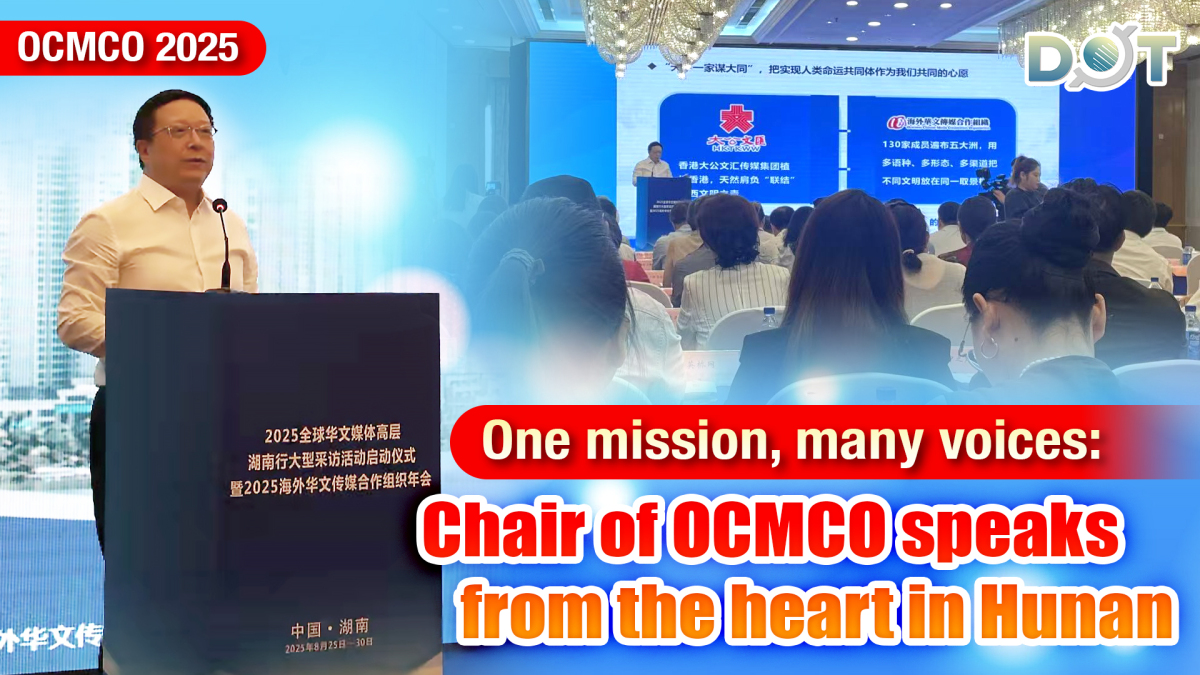(By Alvin)
At the heart of early autumn in Hunan, representatives from Chinese-language media outlets across five continents came together in Changsha to attend the 15th Annual Conference of the Overseas Chinese Media Cooperation Organization (OCMCO) and launch the large-scale interview initiative: "2025 Large-scale Interview Activity for Global Chinese Media Executives in Hunan."
Delivering the keynote address at the opening ceremony was Mr. Li Dahong, Chairman of the Overseas Chinese Media Cooperation Organization, member of the CPPCC National Committee, and Chairman and Editor-in-Chief of Hong Kong Ta Kung Wen Wei Media Group (TKWW Media Group). He warmly welcomed the participating media executives and guests from around the world and extended sincere gratitude to the Hunan provincial government and local partners for their generous support and thoughtful coordination.
"This is more than a media event," Li remarked. "It is a meeting of minds and a convergence of shared missions — to connect, to exchange, and to move forward together."
Li emphasized that no matter where they are based, overseas Chinese media share a common goal — to preserve cultural roots and promote Chinese civilization in creative and engaging ways. "Chinese characters are our vein, Chinese culture is our soul," he said. "We must innovate while remaining true to tradition and carry these stories across generations and borders."
Delivering the keynote address at the opening ceremony was Mr. Li Dahong, Chairman of the Global Chinese Media Cooperation Organization, member of the CPPCC National Committee, and Chairman and Editor-in-Chief of Hong Kong Ta Kung Wen Wei Media Group (TKWW Media Group).
He shared a number of groundbreaking initiatives led by his mediad group in recent years, including a global "Fu" (福) character campaign during Chinese New Year that reached millions of overseas Chinese, and the ongoing "Global Chinese Lens" project, where on-the-ground contributors capture images and videos of Chinese culture across the globe — from national elections to folk festivals and historical commemorations.
"From the aroma of dumplings to the glow of lanterns, from the voice of poets to the flash of digital screens," Li said, "we are making China's story visible, relatable, and alive."
This year's Hunan tour brings over 80 Chinese-language media outlets to the province, where each one will set up a "temporary newsroom" to launch the "Hunan Through Our Lens" initiative. Each outlet, each journalist, each image — all working together to co-create a multimedia portrait of modern Hunan under the theme "Hunan + The World."
Reflecting on the history of overseas Chinese media, Li paid tribute to generations of journalists who have stood firm through wars and hardship while keeping faith in their mission. Now, as China enters a new era of national rejuvenation, the responsibility grows even greater.
He highlighted 2025 as the 80th anniversary of the end of WWII, recalling the heroic role played by overseas Chinese media in telling the world about the Chinese people's resistance and sacrifice. He urged today's media to continue to preserve those red memories, especially in Hunan — a land of revolutionary history, from the Battle of Changde to the surrender at Zhijiang.
But beyond remembering the past, Li stressed the importance of building new bridges — between civilizations, between narratives, and between peoples. Overseas Chinese media, he said, are uniquely positioned: rooted in local society, fluent in both Chinese and global thinking, they can serve as essential intermediaries in a complex world.
"We are not only reporters — we are connectors, translators, and storytellers," he said. "It is our duty to explain not only what China is doing, but why it matters to the world."
Looking ahead, Li underscored the idea of a "community with a shared future for mankind", a concept evolved from China's ancient pursuit of tianxia datong — universal harmony. In today's fragmented world, he said, media must become carriers of empathy and vision, amplifying voices of unity over division.
He noted that the TKWW Media Group, based in Hong Kong, naturally bridges East and West. Meanwhile, the Global Chinese Media Cooperation Organization has grown to 130 member outlets across 44 countries, publishing in diverse formats and languages. Together, these outlets help place different civilizations in the same frame, offering the world a more complete picture of China — and helping China better understand the world.
He described the Hunan visit as a vivid case study of cultural synergy: a region striving to become a global innovation hub and youth entrepreneurship zone, now being documented by dozens of international Chinese-language media outlets, transforming local ambition into global storytelling.
"Let the winds of Yuelu Mountain carry Hunan's voice across continents," Li said passionately. "Let the waves of the Xiang River shine on screens around the world."
Li noted that the organization has expanded from just 18 founding members to 130 today, spanning newspapers, magazines, radio, TV, and digital media, forming a powerful matrix for global Chinese-language communication.
"With shared values come shared hearts," he concluded. "And with shared hearts, we walk the same path."
Over the coming days, he hoped every delegate would fully immerse themselves in the landscape, culture, and innovation of Hunan, and return home with stories that resonate far beyond borders.
"From science parks to mountain peaks, from university labs to riverside streets, this land reflects the vibrant pulse of Chinese modernization," he said. "It is our job to make that pulse felt — vividly, truthfully, and globally."
版权及免责声明:凡本网所属版权作品,转载时须获得授权并注明来源“东盟评论社”,违者本网将保留追究其相关法律责任的权力。凡转载文章,不代表本网观点和立场。版权事宜请联系:。

